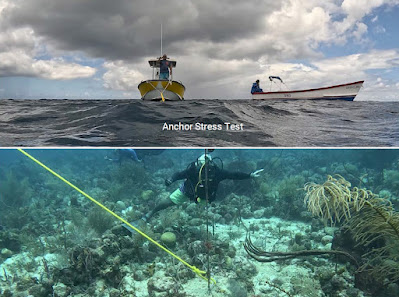them to Port Louis, the starting location for the dive trip to Dottin’s reef. There they were met by three officers of the Folkstone Marine Park. The marina was chosen, because from there it was easiest to load heavy dive equipment, tools and materials onto the boats. Because of the larger group, including six divers, two boats, the 17’ Boston Whaler of the marine park and an additional 21’ pirogue, a fishing vessel, were necessary to conduct the work. The pirogue was captained by a local fisherman. Travel time to Dottin’s reef by boat was approximately 15 minutes.
a) Locate the North- and South U-anchors,b) Confirm depth and GPS coordinates of each anchor,c) Measure the exact distance and cardinal orientation of the anchors in relation to each other,d) Evaluate the condition and suitability to the task of each U-anchor,e) Clean the anchors from marine growth and corrosionf) Perform a stress test to confirm the integrity of the north anchor,g) Scout for potential alternative anchor installation sites.
Dive teams and specific tasks for each diver were assigned, as well as relevant safety procedures reiterated. Because of the well qualified dive team and good coordination, only one, instead of the planned two dives was necessary to accomplish all objectives.
The South U-Anchor proved to be in perfect condition, as already reported in the report by Renata Goodridge. The Folkestone marine park rangers had already cleaned the anchors and there was very little sign of corrosion on the stainless-steel anchors.
Nonetheless, the North U-Anchor was found bent significantly, although it had not moved at all and seemed solidly secured in the bottom substrate. The stress test on the anchor at approximately 2,500 rpm by 2 x 150 hp Yamaha outboard engines showed that it was still very stable and the marine park vessel was not able to bend the U-anchor any further. Hence, there is a high probability that a large vessel had previously tied to it previously, exerting a large force on the system, without damaging it. The continuous force of that vessel had to be much larger than the CREWS buoy could ever pull with, even in harshest conditions. However, a crack seems to have developed between the two embedded anchor pins and some
The stress test on the anchor at approximately 2,500 rpm by 2 x 150 hp Yamaha outboard engines showed that it was still very stable and the marine park vessel was not able to bend the U-anchor any further. Hence, there is a high probability that a large vessel had previously tied to it previously, exerting a large force on the system, without damaging it. The continuous force of that vessel had to be much larger than the CREWS buoy could ever pull with, even in harshest conditions. However, a crack seems to have developed between the two embedded anchor pins and some play could be felt in the upper bore holes when attempting to wriggle the anchor. Hence, it was decided to fortify the existing U-anchor by chiseling the crack deeper and fill it with special two-component “Liquid Rock” epoxy. Additionally, a new drilling spot would be scouted the next day to install a backup single-eyed anchor.
Upon return to the marina, the SCF crew was dropped in St. James, where all equipment was rinsed and prepared for the next day. The underwater footage was transferred to hard drives and batteries charged for the next day.

